This article is day four of a four-part guide too travelling Route 50 in Nevada. On this road trip, you’ll get to experience some of the most jaw dropping landscapes across the silver state. The road trip is so varied, it’s one of the best trips for adventure seekers and features high desert, hot springs and high altitude alpine national parks as well as never ending desert vistas. You can navigate the other days from our Nevada Route 50 itinerary (otherwise known as ‘The Loneliest Road in America’) below:
- Day 1: Carson City to Austin
- Day 2: Austin to Eureka
- Day 3: Eureka to Baker
- Overview: Route 50: Nevada’s Hidden Gem for Adventure Seekers – 4 Day Road Trip
See Nevada’s Route 50 in motion – bring Route 50 to life and watch how we experienced this iconic road trip:
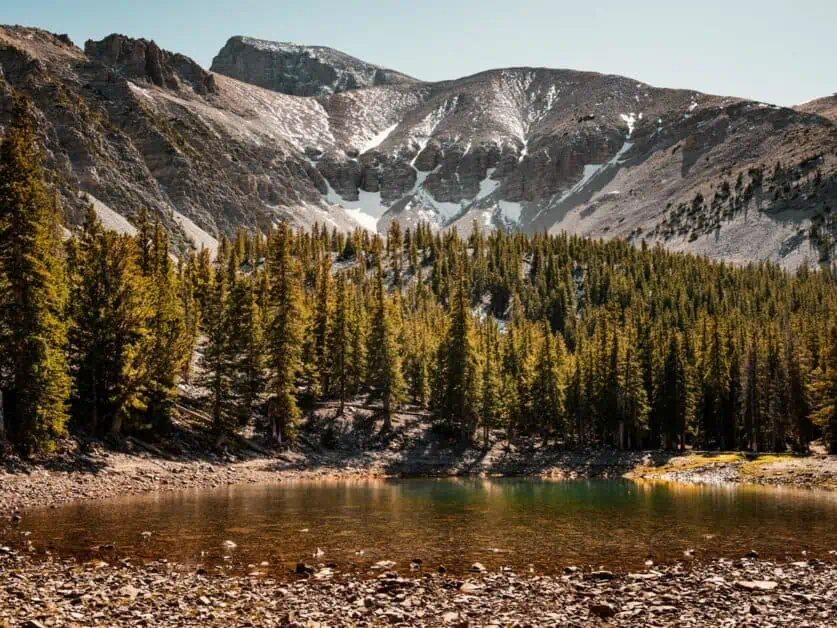
Editor’s Note: This article is in partnership with Travel Nevada, all opinions are our own.
Table of Contents
ToggleDay 4 – Exploring Great Basin National Park
Great Basin National Park seems to be a hidden gem that a lot of people haven’t heard of, and this will be obvious to you when you visit. In fact, when we visited toward the end of September, we didn’t see that many people at all. So, if you love your solitude, and you’ll have had a lot of that in the previous few days of the trip, then you’re going to love this National Park. So, what makes Great Basin National Park special? Well, it’s home to a diverse and rich habitat held in place by the high mountains you’ll find here. In fact, you may almost think it’s position in the desert isn’t even possible and when you start driving up to the hiking trails, you’ll marvel at how different and alpine the area feels in comparison to what is below you in the basin floor.
Great Basin National Park has so much to explore – from Wheeler Peak to alpine lakes, ancient bristlecone pines ranging back 4,000 years in age, caves and so much more. You could very easily spend more time than just one day here, and if you can afford the time, we’d recommend extending to have two days to explore.
Great Basin is best visited from June to October if you want to take advantage of the hiking opportunities below and to see the park ‘at its best’ as the Wheeler Peak Scenic Drive, which connects most of the hiking, is closed due to snowfall from November until May. Autumn/fall is particularly beautiful where you’ll get to see all of those oranges and yellows coming into spectacular profusion.
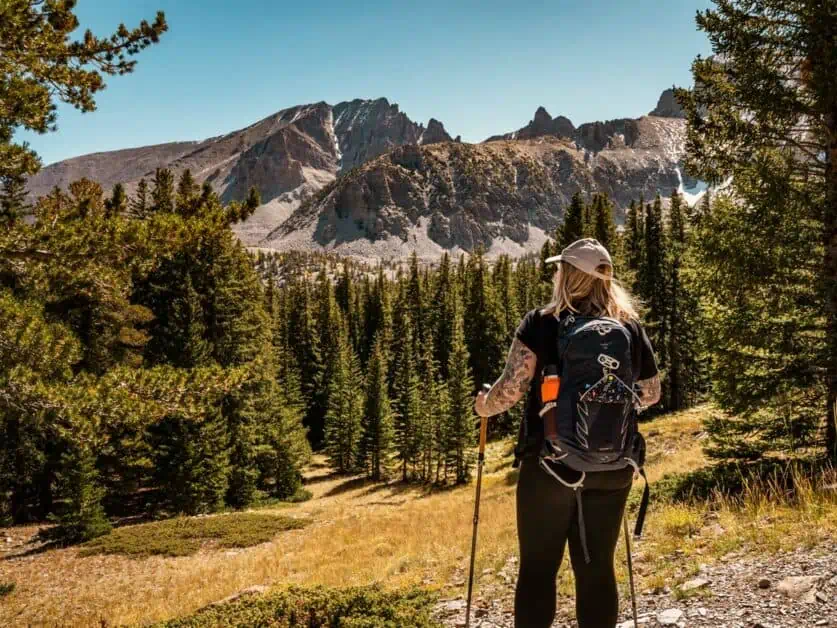
Great Basin National Park Visitor Center
The main Great Basin National Park Visitor Center is located just outside the park, and as you drive up the road to the park, you’ll find the entrance easily from the road. It is a great place to stop before you begin exploring and to get a lay of the land, so to speak. Within the visitor center, there are some great exhibits that give you more information about Great Basin and all of the diversity you will expect to find in the park. There’s so much information about how the different habitats interact with each other and it’s also a great place to take a look at bristlecones (which, if you don’t have time to check out all the trails, may be your only chance to see) as it’s home to a piece of 4,862-year-old tree!
It’s a really interactive place and well worth a visit. It’s free to visit the center and has a gift shop where you can pick up those last memories of your trip. It’s worth checking out the NPS website before you visit for up to date opening hours, but at the time of publishing the Great Basin National Park Visitor Center is open from 8am – 5pm Monday – Sunday. You’ll also find rest rooms available, but no restaurant, so stock up for the day before you arrive. You can contact the center by phone at +1 775 234 7520.
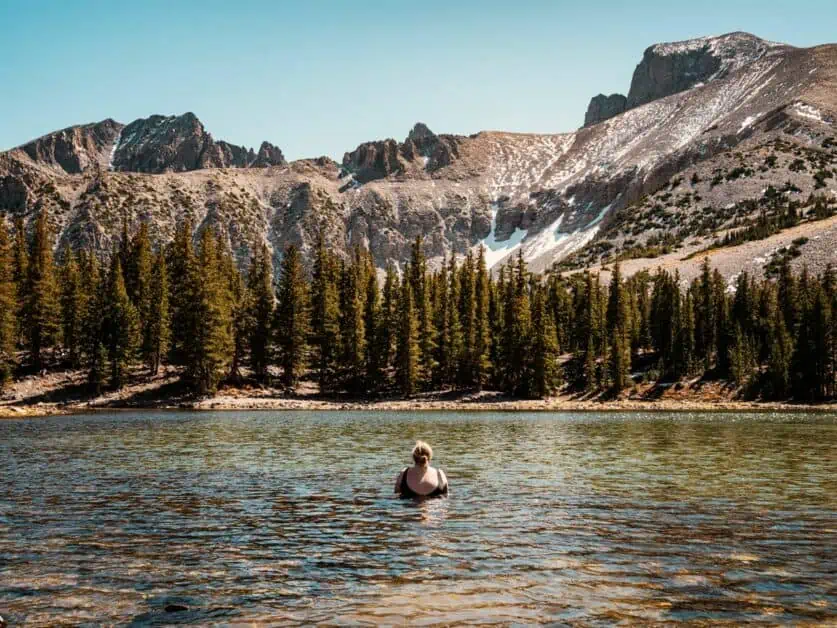
Lehman Caves Visitor Center
The Lehman Caves Visitor Center is just 5.5 miles from Baker, Nevada. The visitor center is a great place to plan your visit to Lehman Caves and purchase cave tour tickets. You can also watch a film about the park and there are various exhibits to check out which are different from the main visitor center, so it’s well worth checking out. Here, you’ll find fascinating information about the Lehman Caves, as well as more information about the stunning dark skies Great Basin National Park offers for stargazing.
The Lehman Caves Visitor Center has a restaurant, bar, sells snacks and offers information for your visit as well as a souvenir and gift shop. There are also picnic tables outside as well as accessible and family restrooms. It is best to check out the NPS website in advance for any changes to opening times due to seasonality, but the visitor center is generally open from 8am – 5pm Monday – Sunday. It’s free to visit, and the visitor center can be contacted on +1 775 234 7520.
Lehman Caves
Lehman Caves are well worth a visit when checking out Great Basin National Park. It’s one of the largest stunning marble caves in Nevada. The reason for its name, is its discovery by Absalom Lehman in the late 1880s after he experienced a cool breeze coming from the ground. He found a natural entrance and inside, he discovered the various stalactites, stalagmites and over 300 rare shield formations that the caves are well known for. Tours have been held of Lehman Caves well before the area became a National Park and is home to a number of creatures who only exist here (making it even more curious and magical).
It’s still possible to take a tour of Lehman Caves, and in fact, is only accessible by doing so. The caves can be seen by either partaking in a 60- or 90-minute tour, which explore fascinating areas of the elaborate caves and systems. You can take the Grand Palace Tour (90 minutes) or the Lodge Room Tour (60 minutes). The tours are limited in visitor numbers, so they sell out quickly. You will need to book in advance through Recreation.gov and pay for your ticket there also.
General rules and common-sense safety prevail in the caves. They can become claustrophobic, and there is the option to be guided out if you feel you need to. You should bring a light jacket as it is likely to be humid but around 52F/11C. You should not bring food, drinks or other contaminants into the caves, as well as bags, though you can bring a camera, but you should leave anything else at the visitor center. You’ll need to supervise children under 15 and you should not touch the cave.
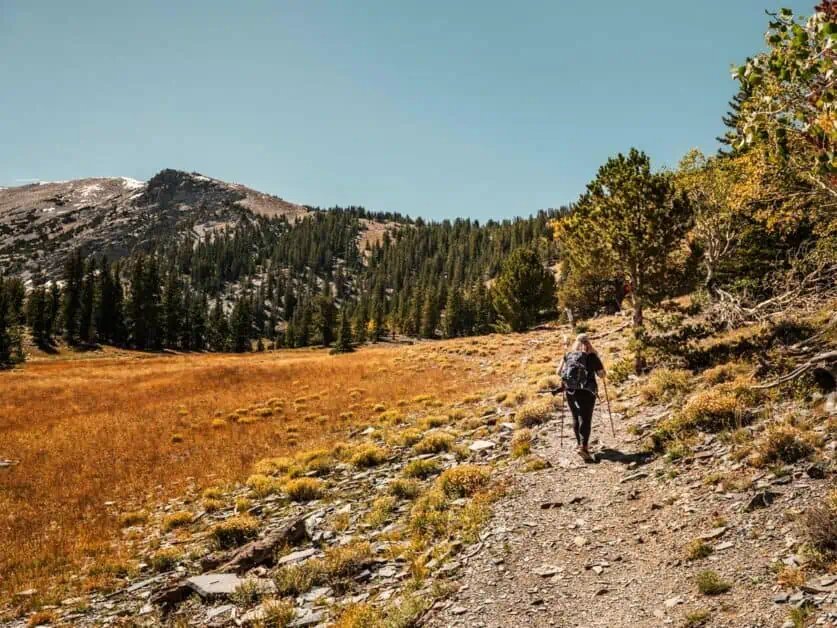
Wheeler Peak
Wheeler Peak is the tallest mountain in Great Basin National Park, sitting at 4,013m/13,161 ft, and given its size, it’s significant as the park’s highest peak. It’s also the second highest peak in Nevada, just behind Boundary Peak. Not only does Wheeler Peak have an obvious appeal for summiting due to its size and relativity throughout the state, it is also responsible for a lot of the ecological diversity you’ll see in Great Basin National Park.
On its slopes, there are ancient trees, called bristlecone pines, some which are over 4,000 years old. These can actually be seen in more detail by following the Bristlecone Pine Glacier Trail outlined below to get a closer look at these fascinating, preserved relics of history. From here, you can also have good access to the Wheeler Peak Glacier too, which is actually the only remaining glacier in Nevada. You’ll see some of the most stunning views of Wheeler Peak not from the Wheeler Peak trail itself, but actually from some of the other trails, such as the Alpine Lakes Loop. However you experience the park, you’ll be sure to see Wheeler Peak as it sits at absolute proud prominence over the whole landscape.
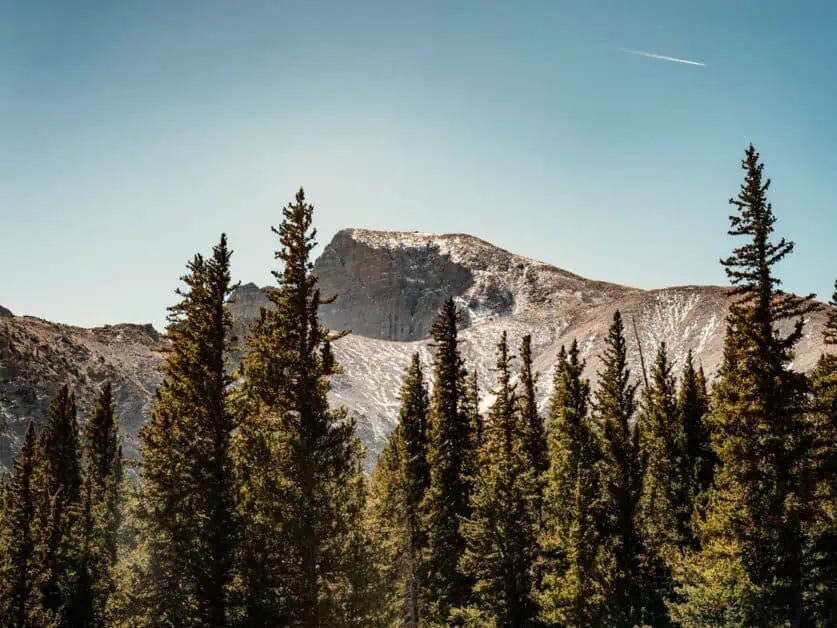
Best Hiking Trails in the Great Basin National Park
One of the greatest things about Great Basin National Park is its hiking trails. You’ll find a great sense of solitude here due to its off the beaten path location and this makes the hiking trails even better to explore, and get a sense of being amongst these vast, larger than life landscapes. Great Basin National Park doesn’t have a huge amount of hiking trails, but the trails they do have are up there with some of the best hiking we’ve done around the world. If you want a real treat, be sure to visit during fall/autumn to have the best chance of seeing the orange and red larch trees surrounding the alpine mountain views. Below, we’ve outlined some of the best hiking trails in Great Basin National Park for you to explore.
Bristlecone Pine Glacier Hiking Trail
Difficulty: Some elevation gain at significant altitude with exposure on the trail makes this trail classed as moderate
Distance: 7km/4.34 miles
Elevation: 288m/944 ft. ascent and descent
When to do it: Best time is from April to early October due to snowfall in winter and road closures
This trail is something to remember and presents a spectacular way to see the landscape of Great Basin National Park. The trail is well maintained and even though there aren’t that many markings on the trail itself, it’s easy to follow. Be mindful that you are hiking at altitude so the air will likely feel thinner, but all in all, if you take it steady this trail is really worth the effort. The trail starts out through forested areas and climbs up to a bristlecone pine grove, where you’ll get to take in trees that are up to and even over 4,000 years old – that’s kind of hard to comprehend.
There are plenty of signs and interpretations to read and its fascinating to see. At this point, you can spend time admiring the bristlecones, and turn around back to the parking lot or continue up to the glacier. From here, the trail does climb more substantially, and become rockier. However, the views are well worth the effort. This hike can also be combined with the Alpine Lakes loop outlined below for a longer variant and more of a challenge. You won’t be disappointed if you hike this trail!
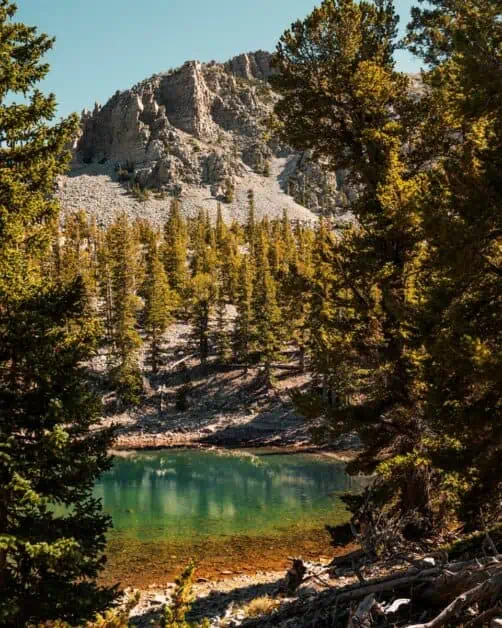
Alpine Lakes Loop
Difficulty: Due to high altitude and rocky terrain, this hike is rated as moderate
Distance: 4.3km/2.67miles
Elevation: 152m/498ft. ascent and descent
When to do it: Best completed between April and October, due to snowfall and potential road closures deeming the trail inaccessible
If you’re only going to experience one hike in Great Basin National Park, the Alpine Lakes loop should be at the top of your list. Why? It packs in some of the most stunning alpine scenery you can expect to see, is incredibly varied and doesn’t leave a moment without a view that will take your breath away. The hike starts from the same parking lot as the Bristlecone Pine and Glacier Trail (which you can combine with this trail, if you fancy it), and once you’re out on the trail, you’ll follow this for a while before your turn off. In this hike, you’ll get to take in two stunning lakes: Stella Lake and the smaller Teresa Lake.
As you wind up hill on the trail, you’ll be treated to stunning views of Wheeler Peak and the surrounding peaks, so take every opportunity to catch your breath and take photos. Stella Lake is a great place for a refreshing swim – though do keep in mind it stays cold all year round due to its high altitude. You will feel the thin air here so take your time. Once you’ve finished up taking in Stella Lake, you’ll head down to Teresa Lake, which, depending on the time of year you visit may be very full or crystal-clear blue water, or not so much (though you’ll likely see water all year round).
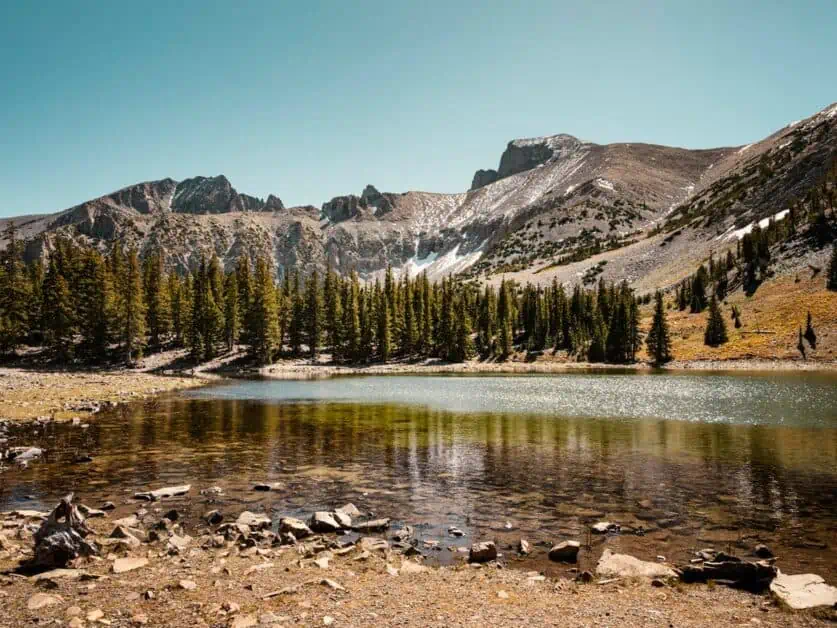
Wheeler Peak Trail
Difficulty: With significant elevation gain at altitude and a long hike, this trail is classed as challenging
Distance: 15km/9.3miles
Elevation: 1,014m/3326ft. ascent and descent
When to do it: Between late May and mid-October, due to snowfall and road closures in the area leading up to the trailhead
This hike attracts a lot of people, due to it being the tallest mountain in Great Basin National Park and also the second highest peak in Nevada, but this should not be attempted unless you have a good level of experience of hiking and know this peak is within your sights. The peak is at high altitude, and the trail to it and back is long, so combining all of those things, as well as a head for heights should inform your decision.
That said, this is a stunning hike, and the views are beyond mesmerizing. If summiting in October, or even late September, be prepared for snow and ice on the trail, so micro spikes and hiking poles are a must for safety and always be prepared to turn around if the trail gets out of your comfort zone. For the first couple of miles/km up the trail, the incline is gradual, but after this, things become a lot steeper. It’s certainly one to remember and you won’t be disappointed with your effort and the views!
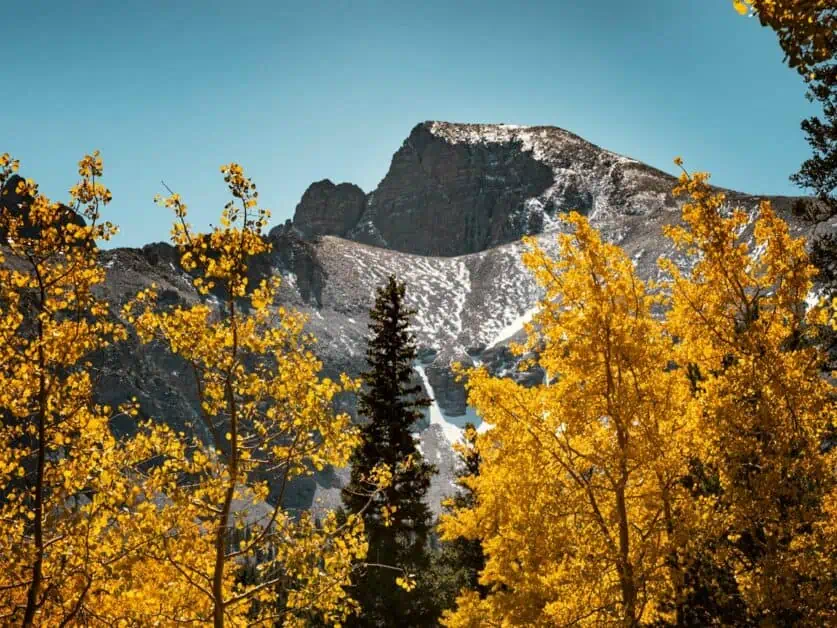
Wheeler Peak Scenic Drive
The main drive through Great Basin National Park is well worth doing, even if you don’t plan to go hiking with your time in the park. The Wheeler Peak Scenic Drive starts from the main National Park entrance and ends at Wheeler Peak Campground. Its 19km/12 miles and takes you through true alpine mountain scenery with stunning views over Great Basin below you and the ecosystems before you. You can take the Self-Guided Auto Tour ‘Great Basin Life Zones’ which can be found on the NPS app, and allows you to find out about the delicate life that exists all around you. That said, even if you focus on simply driving the road without the app, you will still get to see everything on offer.
The road is paved, so you can focus on the journey, and if you’re going hiking to any of the trails we’ve listed above, you’ll drive the Wheeler Peak Scenic Drive to get there anyway. Make sure you have your camera handy as you’ll want to stop numerous times to take in the stunning landscapes. Be sure to check out the numerous scenic points along the way, including varying species of sagebrush, Pinyon Pine, Curleaf Mountain mahogany, conifers and aspen, to name a few. Be mindful that the driving route is closed from November to June due to snowfall, so be sure to plan accordingly.
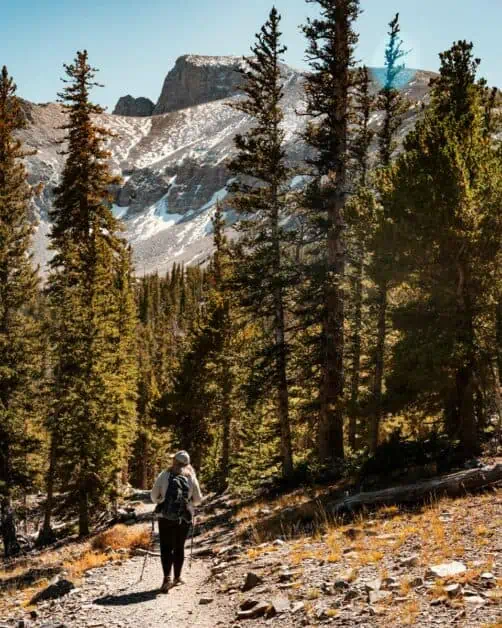
Conclusion
Day four of our Route 50 road trip through Nevada was in some ways one of our favorite days – and that is a hard thing to say, as there were just so many incredible things to see and do along the way. However, Great Basin National Park left things on a real high, and we were particularly lucky to visit around the time that the trees were starting to turn and everything just looked at its most beautiful. We loved the hiking in Great Basin National Park the most – in fact, it was some of the best hiking we’ve ever experienced – the views particularly from the Alpine Lakes Trail are jaw dropping and swimming in the cool waters of the lakes was a real highlight too!
It’s important to keep in mind that Great Basin National Park is at significant altitude, and so you will feel out of breath quicker – so even if you’re used to hiking the length trails we’ve outlined, give yourself more time than you think you’ll need to account for rest breaks. We would also recommend, if possible, extending the time you spend in the National Park and enjoying some of the hikes, drives and even the Lehman Caves on different days. Great Basin National Park is a real treat to end your trip through Nevada’s Route 50 – make sure you bring your camera!
